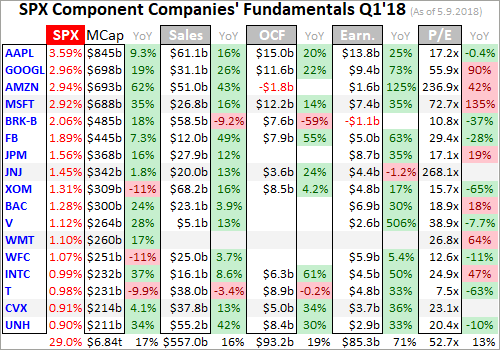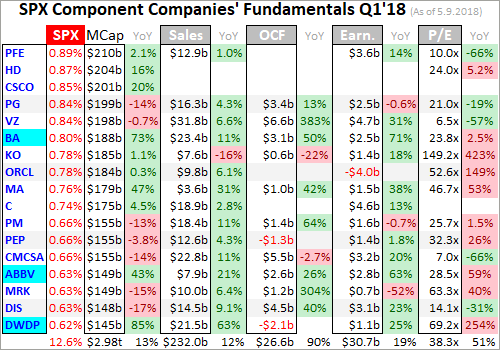The mega-cap stocks that dominate the US markets are just wrapping up a truly-extraordinary earnings season. Naturally this first quarter under Republicans’ new corporate tax cuts fueled surging profits. But sales were up big too, which is no mean feat for massive companies. With sustained growth at this torrid pace impossible, peak-earnings fears are mounting. And valuations stayed extremely expensive exiting Q1.
Four times a year publicly-traded companies release treasure troves of valuable information in the form of quarterly reports. Required by the US Securities and Exchange Commission, these 10-Qs contain the best fundamental data available to investors and speculators. They dispel all the sentimental distortions inevitably surrounding prevailing stock-price levels, revealing the underlying hard fundamental realities.
The deadline for filing 10-Qs for “large accelerated filers” is 40 days after fiscal quarter-ends. The SEC defines this as companies with market capitalizations over $700m. That currently includes every single stock in the flagship S&P 500 stock index, which includes the biggest and best American companies. As Q1’18 ended, the smallest SPX stock had a market cap of $2.1b which was 1/410th the size of leader Apple (NASDAQ:AAPL).
The middle of this week marked 39 days since the end of calendar Q1, so almost all of the big US stocks of the S&P 500 have reported. The exceptions are companies running fiscal quarters out of sync with calendar quarters. Walmart (NYSE:WMT), Home Depot (NYSE:HD), and Cisco (NASDAQ:CSCO) have fiscal quarters ending in April instead of the usual March, so their “Q1” results weren’t out yet as of this Wednesday. They’ll arrive in the coming weeks.
The S&P 500 (SPX) is the world’s most-important stock index by far, weighting the best US companies by market capitalization. So not surprisingly the world’s largest and most-important ETF is the SPDR S&P 500 ETF (NYSE:SPY) which tracks the SPX. This week it had net assets of a staggering $256.7b! The iShares Core S&P (NYSE:IJR) and Vanguard S&P 500 (NYSE:VOO) also track the SPX with $149.9b and $88.5b of net assets.
The vast majority of investors own the big US stocks of the SPX, as they are the top holdings of nearly all investment funds. So if you are in the US markets at all, including with retirement capital, the fortunes of the big US stocks are very important for your overall wealth. Thus once a quarter after earnings season it’s essential to check in to see how they are faring fundamentally. Their results also portend stock-price trends.
Unfortunately, my small financial-research company lacks the manpower to analyze all 500 SPX stocks in SPY each quarter. Support our business with enough newsletter subscriptions, and I would gladly hire the people necessary to do it. For now we’re digging into the top 34 SPX/SPY components ranked by market capitalization. That’s an arbitrary number that fits neatly into the tables below, but a commanding sample.
As of the end of Q1’18 on March 29th, these 34 companies accounted for a staggering 41.7% of the total weighting in SPY and the SPX itself! These are the mightiest of American companies, the widely-held mega-cap stocks everyone knows and loves. For comparison, it took the bottom 426 SPX companies to match its top 34 stocks’ weighting. The entire stock markets greatly depend on how the big US stocks are doing.
Every quarter I wade through the 10-Q SEC filings of these top SPX companies for a ton of fundamental data I dump into a spreadsheet for analysis. The highlights make it into these tables below. They start with each company’s symbol, weighting in the SPX and SPY, and market cap as of the final trading day of Q1’18. That’s followed by the year-over-year change in each company’s market capitalization, a critical metric.
Major US corporations have been engaged in a wildly-unprecedented stock-buyback binge ever since the Fed forced interest rates to deep artificial lows during 2008’s stock panic. Thus the appreciation in their share prices also reflects shrinking shares outstanding. Looking at market-cap changes instead of just underlying share-price changes effectively normalizes out stock buybacks, offering purer views of value.
That’s followed by quarterly sales along with their YoY changes. Top-line revenues are one of the best indicators of businesses’ health. While profits can be easily manipulated quarter-to-quarter by playing with all kinds of accounting estimates, sales are tougher to artificially inflate. Ultimately, sales growth is necessary for companies to expand, as bottom-line earnings growth driven by cost-cutting is inherently limited.
Operating cash flows are also important, showing how much capital companies’ businesses are actually generating. Using cash to make more cash is a core tenet of capitalism. While most of these elite US companies reported Q1’18 OCFs as they should, some obscured quarterly results by lumping them in with the past 6 or 9 months. So these tables only include Q1 operating cash flows if specifically reported.
Next are the actual hard quarterly earnings that must be reported to the SEC under Generally Accepted Accounting Principles. Late in bull markets, companies tend to use fake pro-forma earnings to downplay real GAAP results. These are derided as EBS earnings, Everything but the Bad Stuff! Companies often arbitrarily ignore certain expenses on a pro-forma basis to artificially boost their profits, which is very misleading.
While we’re also collecting the earnings-per-share data Wall Street loves, it’s more important to consider total profits. Stock buybacks are executed to manipulate EPS higher, because the shares-outstanding denominator of its calculation shrinks as shares are repurchased. Raw profits are a cleaner measure, again effectively neutralizing the impacts of stock buybacks. They better reflect underlying business performance.
Finally, the trailing-twelve-month price-to-earnings ratio as of the end of Q1’18 is noted. TTM P/Es look at the last four reported quarters of actual GAAP profits compared to prevailing stock prices. They are the gold-standard metric for valuations. Wall Street often intentionally obscures these hard P/Es by using the fictional forward P/Es instead, which are literally mere guesses about future profits that often prove far too optimistic.
As expected given the largest corporate tax cuts in US history going live, the big US stocks generally reported spectacular Q1’18 results. Sales, OCFs, and earnings surged dramatically! But much of this tax-cut windfall was anticipated, as valuations remained dangerously high at the end of last quarter. It’s hard to imagine such blistering growth of such enormous mega-cap companies being able to persist for long.


Not surprisingly the S&P 500’s top-constituent list was little changed over the past year. Most of these elite American companies investors love only grew larger. Three stocks did claw their way into the top 34 since Q1’17, and their symbols are highlighted in light blue. Boeing (NYSE:BA), AbbVie (NYSE:ABBV), and DowDuPont (NYSE:DWDP) saw their stocks soar enough to help knock out General Electric (NYSE:GE), IBM (NYSE:IBM), and Altria (NYSE:MO) from the ranks of the top 34 big US stocks.
From the ends of Q1’17 to Q1’18, the SPX itself powered 11.8% higher. This past year was one of great anticipation and euphoria for the expected big corporate tax cuts coming soon. These top 34 SPY stocks outperformed the markets considerably, with big average market-cap gains of 14.6% YoY. More capital inflows concentrating in fewer stocks highlights the increasing narrowness and riskiness of these toppy markets.
As bull markets mature, the breadth of their advances increasingly narrows. Investors flock into the best-performing stocks to chase their superior gains. Thus decreasing numbers of market-darling stocks are wielding outsized influence on overall stock-market fortunes. They shoulder more of the burden, which is a double-edged sword. When selling erupts in these leaders for any reason, it hits the broader markets hard.
Ominously, the universally-adored and -owned mega-cap tech stocks still dominated the SPX at the end of Q1. That was despite the SPX suffering its first correction in 2.0 years, a sharp-yet-shallow plunge of 10.2% in just 9 trading days. That started to crack this past year’s extraordinary tech-stock euphoria, but that selloff was too short to really change psychology. So investors still love the leading technology stocks.
Apple, Alphabet (NASDAQ:GOOGL), Amazon (NASDAQ:AMZN), and Microsoft (NASDAQ:MSFT) tower over the rest of the top SPY stocks, alone accounting for 1/8th of the entire SPX’s weighting! Facebook (NASDAQ:FB) wasn’t far behind at 6th after Warren Buffett’s Berkshire Hathaway (NYSE:BRKa). In Q1’18 these top 5 tech stocks indeed seemed to earn their keep, with average results far better than the other big US companies. They reported incredible average top-line sales growth of 29.8% YoY!
At 30% annual revenues growth, sales will double about every 2.6 years. That’s never sustainable for long even in far-smaller companies, and is economically impossible at the size and scale of the mega-cap techs. Despite their awesome and amazing success, these 5 US companies aren’t going to take over the entire US economy. This past year was an extreme outlying anomaly that inevitably has to mean revert.
Never before have stock markets relentlessly powered higher to seemingly-endless new record closes with the lowest volatility ever witnessed. Especially with the stock markets literally trading at bubble valuations all year. Never before have the entire American business and investment communities been able to spend over a year eagerly anticipating the biggest corporate tax cuts in US history. 2017 wasn’t normal!
I’ve been blessed to spend decades studying the markets full-time, all day every day. And certainly one of the most stunning revelations is how broadly and deeply stock-market fortunes affect nearly everything else in the entire economy! Record-high stock markets breed epic levels of optimism about the future and thus abnormally-high levels of spending, both from businesses and individuals. That greatly boosts sales.
These mega-cap tech stocks had the great fortune of riding that big-tax-cuts-coming-soon wave of stock-market euphoria. Americans eager to splurge flocked to buy Apple’s latest iPhones and iPads, which are great but expensive products. If the stock markets had ground lower breeding pessimism, that big Apple upgrade cycle would’ve lengthened as people made do with older devices with almost the same functionality.
Businesses rushed to capitalize on the gold rush of surging consumer spending, advertising heavily on both Alphabet and Facebook. They also rushed to expand their online operations by leasing cloud servers and services from Amazon, Microsoft, and Alphabet. What will happen to this huge business spending to market and grow as stock markets roll over and consumers and companies pull in their horns?
The sheer levels of spending over this past totally-unique year that fueled such incredible sales growth aren’t sustainable. Both consumers and businesses racked up huge new debt to fuel their euphoric buying binges. They won’t keep stacking on debt with interest rates rising and the once-in-a-lifetime extreme optimism on big tax cuts soon fading. The mega-cap tech stocks, and all big US stocks, face slowing sales.
The real shock is not that sales ballooned so dramatically in such a perfect year for bullish sentiment, but that Wall Street is arguing such growth is the new norm. These top 34 SPX companies that had reported Q1 results as of this Wednesday had $789.0b of revenues. Those would double about every 5.3 years even at Q1’s average 14.0% YoY growth rate. These 34 companies can’t gobble up the entire world economy!
These big US stocks’ operating cashflows in Q1 highlight the unsustainability of these results. The 24 top SPY components reporting Q1 OCFs saw incredible average gains of 52.5% YoY. There’s just no way giant mature companies can keep expanding their businesses’ cash generation at such blistering rates. OCFs leverage revenues both ways, so naturally sharply-rising sales are going to catapult OCFs higher.
Of course profits also amplify sales, so the corporate profits of these top 34 US companies surged even more dramatically in Q1. They averaged gargantuan growth of 45.9% YoY! While not sustainable, that’s a reasonable 3.3x the increase in sales. The total earnings of the 31 of these 34 giant companies that had reported as of the middle of this week ran a colossal $116.0b, making for profit margins of about 1/7th.
While those are big profits, surprisingly they only grew 3.4% quarter-on-quarter from Q4’17. Remember that quarter was the last under the old higher-corporate-tax regime. Given all the corporate-tax-cut hype leading into Q1’18 which was again the tax cuts’ maiden quarter, you’d think corporate profits would’ve surged far more than 3.4% QoQ. But that gain is somewhat understated given big adjustments on Q4’17 results.
In my recent essay on big US stocks’ Q4’17, I discussed how nearly all of these elite companies had to make significant-to-huge earnings adjustments to account for the new Tax Cuts and Jobs Act of 2017. With corporate tax rates being slashed, the values of existing deferred tax assets and liabilities on many corporate balance sheets changed dramatically. These differences had to be flushed through Q4 income statements.
Basically companies that had overpaid or underpaid their taxes in the past had to adjust for new lower corporate tax rates going forward. The absolute value of all these adjustments for the top 34 US stocks was a mind-boggling $209.2b in Q4’17, dwarfing actual GAAP profits of $112.2b! But interestingly it was a wash overall, with positive profits boosts and negative profits hits evening out to a net gain of just $2.7b.
Without those big one-time corporate-tax-cut earnings adjustments, overall top-34-SPY-company profits were up 6.0% QoQ in Q1’18. That’s big, not still not as hefty as stock-market euphoria seemed to imply was coming. When corporate-sales growth inevitably stalls, so will profits growth. If revenues actually start to shrink, earnings will decline at several times that rate. So the peak-earnings fears are righteous!
Since it’s hard to imagine a better year psychologically for driving big spending than 2017, odds are the corporate-sales environment will mean revert lower with stock-market fortunes and sentiment. And if that indeed proves true, corporate profits have hit or are hitting their high-water mark for a long time to come. We really may not see such crazy earnings growth again until the next secular stock bull tops years into the future.
The SPX-leading market-darling tech stocks Alphabet, Amazon, Microsoft, and Facebook rely heavily on business spending. Last year was a banner year for business confidence on the coming huge tax cuts, leading to giant leaps in spending for online advertising and back-office data services. When the next recession inevitably arrives with the overdue stock bear, much of that euphoric spending will wither and reverse.
On the valuation front, these big US stocks were frightfully expensive exiting Q1’18. They sported scary average trailing-twelve-month price-to-earnings ratios of 46.0x. That’s closing in on double the classic bubble threshold of 28x! Over the past century and a quarter or so, the average fair-value valuation for the stock markets was half that at 14x. So there’s no doubt these stock markets are exceedingly expensive.
Since these TTM P/E ratios came from the end of Q1 before its big surge in earnings, we can attempt to adjust for that. With these top 34 SPX companies’ profits up 6.0% QoQ excluding tax-cut adjustments, we can generously assume valuations fell 10%. But even if that is somehow 20%, the big US stocks’ average P/Es are still well into bubble territory at 36.8x. Traders have anticipated tax-cut profits for over a year.
Thus the big corporate tax cuts’ earnings boost has long since been more than fully priced in. But maybe offsetting these extreme overvaluations a bit is those big TCJA adjustments in Q4. One reason the P/Es of Alphabet and Microsoft are so high is they took colossal $9.9b and $13.8b hits to earnings in Q4’17 to account for lower corporate taxes going forward. These are one-time distortions not reflective of ongoing operations.
